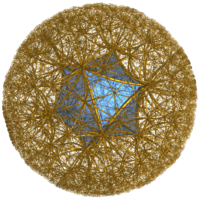- Icosahedral honeycomb
-
Icosahedral honeycomb 
Poincaré disk modelType regular hyperbolic honeycomb Schläfli symbol {3,5,3} Coxeter-Dynkin diagram 






Cells icosahedron {3,5} Faces triangle {3} Edge figure triangle {3} Vertex figure 
dodecahedronCells/edge {3,5}3 Cells/vertex {3,5}12 Dual Self-dual Coxeter group J3, [3,5,3] Properties Regular The icosahedral honeycomb is one of four regular space-filling tessellations (or honeycombs) in hyperbolic 3-space.
Three icosahedra surround each edge, and 12 icosahedra surround each vertex, in a regular dodecahedral vertex figure.
The dihedral angle of a Euclidean icosahedron is 138.2°, so it is impossible to fit three icosahedra around an edge in Euclidean 3-space. However in hyperbolic space, properly scaled icosahedra can have dihedral angles exactly 120 degrees, so three of these fit around an edge.
Related honeycombs
There are nine uniform honeycombs in the [3,5,3] Coxeter group family, including this regular form as well as the bitruncated form, t1,2{3,5,3},






 , also called truncated dodecahedral honeycomb, each of whose cells is a truncated dodecahedron.
, also called truncated dodecahedral honeycomb, each of whose cells is a truncated dodecahedron.See also
- Seifert–Weber space
- List of regular polytopes
- Convex uniform honeycombs in hyperbolic space
- 11-cell - An abstract regular polychoron which shares the {3,5,3} Schläfli symbol.
References
- Coxeter, Regular Polytopes, 3rd. ed., Dover Publications, 1973. ISBN 0-486-61480-8. (Tables I and II: Regular polytopes and honeycombs, pp. 294-296)
- Coxeter, The Beauty of Geometry: Twelve Essays, Dover Publications, 1999 ISBN 0-486-40919-8 (Chapter 10: Regular honeycombs in hyperbolic space, Summary tables II,III,IV,V, p212-213)

This Polychora article is a stub. You can help Wikipedia by expanding it.
